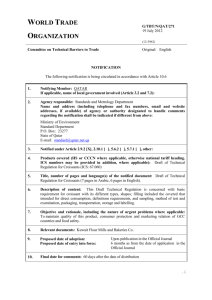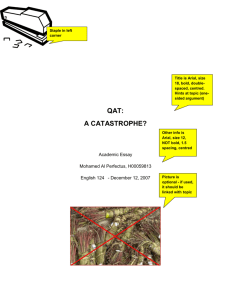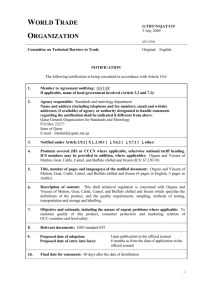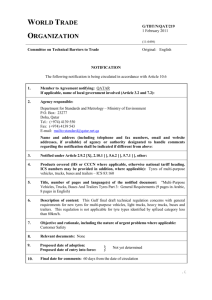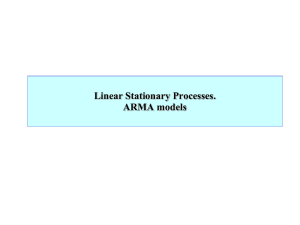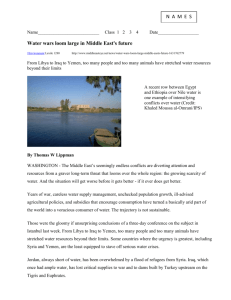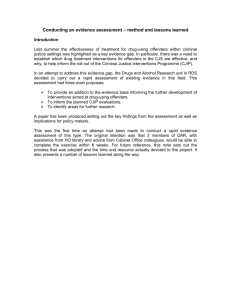Texas Project Delivery Framework Handbook
advertisement
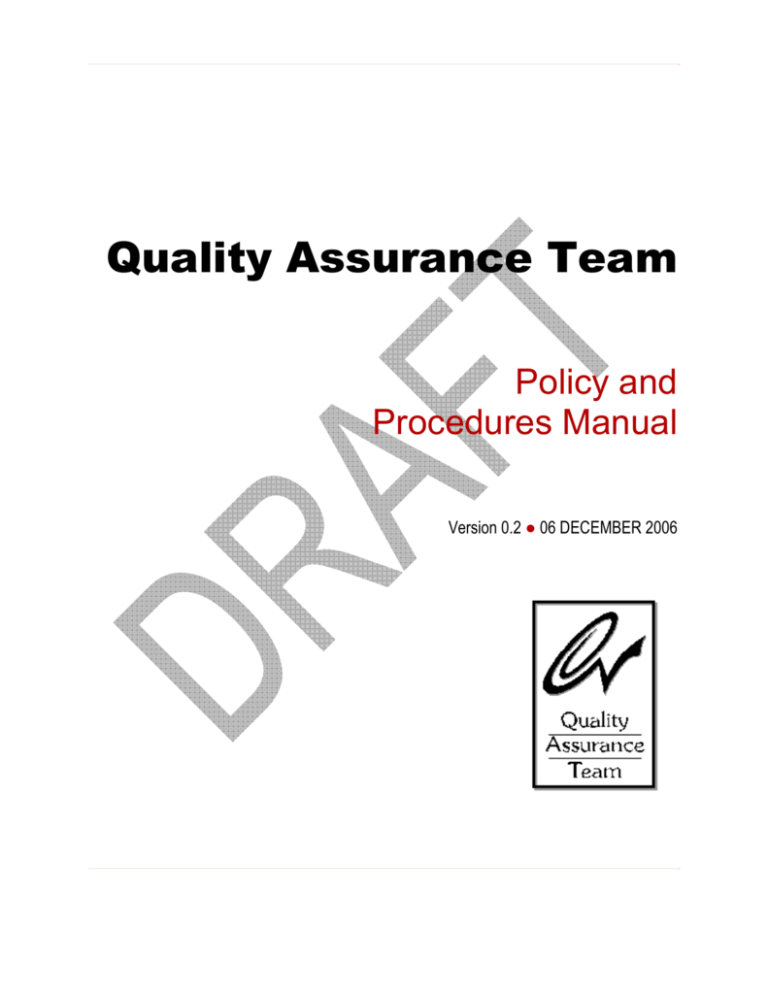
Quality Assurance Team Policy and Procedures Manual Version 0.2 ● 06 DECEMBER 2006 Version History Quality Assurance Team information is available at www.qat.state.tx.us/. Release Date Version December-2006 1.0 Quality Assurance Team Policy and Procedures Manual released and superseded the Quality Assurance Review Guide for Major Information Resources Projects. November-1996 1.0 Quality Assurance Review Guide for Major Information Resources Projects released and superseded the Guidelines for Quality Assurance Review. February-1994 2.9 Guidelines for Quality Assurance Review released. ii Description Quality Assurance Team | November, 2006 Contents Preface .................................................................................................................. iv 1.0 Introduction ...................................................................................................5 1.1 Manual Overview .............................................................................5 1.2 Process Overview............................................................................6 1.3 Data Overview .................................................................................8 2.0 Policy Statements.............................................................................................8 3.0 State Project Portfolio Updating .................................................................10 3.1 Project Identification ......................................................................10 3.2 Project Tracking.............................................................................11 3.3 Project Approval ............................................................................11 4.0 Project Monitoring...........................................................................................12 4.1 Project Selection............................................................................13 4.2 Monitoring Schedule Definition ......................................................13 4.3 Project Performance Assessment .................................................13 5.0 Project Verification..........................................................................................14 5.1 5.2 Validate Project Closure ................................................................15 Assess Project Results ..................................................................15 6.0 Project Reviews..............................................................................................15 6.1 Project Review Schedule Definition...............................................16 6.2 Project Review Meetings ...............................................................16 7.0 State Project Portfolio Reporting ....................................................................17 7.1 Project Portfolio Report..................................................................17 7.2 Annual Report ................................................................................17 7.3 Scorecard.......................................................................................18 Appendix A – Quality Assurance Review Project Flow ........................................19 Appendix B – Forms .............................................................................................20 Appendix C – Service Levels................................................................................21 Appendix D – Glossary.........................................................................................22 Appendix E – Frequently Asked Questions (FAQ) ...............................................25 Appendix F – Contact Information ........................................................................26 QAT Policy and Procedures Manual | Version 1.0 iii Preface The 73rd Legislature (1993) enacted Article V, Section 133 of the General Appropriations Act. This Act established the Quality Assurance Team (QAT) comprised of representatives from the Legislative Budget Office (LBB), the State Auditor’s Office (SAO), and the Department of Information Resources (DIR) to approve and review major information resources projects. The 74th Legislature continued emphasis on quality assurance by including an Article IX rider in the General Appropriations Act that established a quality assurance review process that must be followed for all major information resources projects. The LBB, SAO, and DIR adopted a charter which represents a common understanding of the authority and responsibilities of QAT. The QAT Charter is the basis for determining and fulfilling all actions executed by the QAT. Refer to the QAT Charter for additional information about QAT purpose, organization, roles, and responsibilities. QAT, responsible for implementation of quality assurance review in Texas, continuously seeks to improve its processes. A publication, entitled Guidelines for Quality Assurance Review, was first issued to state agencies and universities in February 1994 to support the legilation enacted in the 73rd Legislative Session. A publication, entitled Quality Assurance Review Guide for Major Information Resources Projects (Guide), superseded the Guidelines for Quality Assurance Review in November 1996 in entirety. The Guide represented the extension of the legislation directing statewide quality assurance review of major information resources projects. Based on further experience with quality assurance review since 1994, QAT published this Policy and Procedures Manual which superseded the Guide in entirety. This QAT Policy and Procedures Manual maintains the same intent of the Guide – clarifying QAT processes – by extending definition and description of all QAT policies and procedures. iv Quality Assurance Team | November, 2006 1.0 Introduction 1.1 Manual Overview The QAT Policy and Procedures Manual (Manual) presents the entire scope of QAT processes and represents the structure by which QAT currently conducts standard quality assurance review for information resources projects. The Manual is not intended to replace, convey, nor endorse specific project delivery methodologies and standards. As an extension to the QAT Charter, the Manual is revised continuously to complement the QAT Charter and to reflect current QAT processes established in response to legislative direction for the state of Texas. The primary purpose of this Manual is to describe policy and procedures as established by the QAT. The Manual can also be used by agencies (state agencies and higher education institutions) as a basis for definition and implementation of internal practices that are impacted by QAT processes. Separate sources of information as follows should be used with the Manual for further clarification on topics, processes, and referenced documents that are outside the scope of QAT. Texas Legislative Process http://www.lbb.state.tx.us/Budget/TwoYearBudgetCycle_Graphic_0706.pdf Information Technology Detail http://www.lbb.state.tx.us/The_LBB/Access/Instructions.htm Texas Project Delivery Framework http://www.dir.state.tx.us/pubs/framework/index.htm Contract Advisory Team http://www.tbpc.state.tx.us/communities/procurement/prog/SC/SC_main The Manual is organized by section to correspond with progression of quality assurance review processes throughout a project’s life cycle. First, basic information for understanding QAT processes collectively is introduced, including a quality assurance review graphic. Second, QAT policy statements for application to agency project delivery practices are identified. Third, information for each major quality assurance review process is described in further detail. Overall, the Manual is organized as follows: Introduction Process Overview Data Overview Provides foundational information and terminology for understanding QAT processes Describes data methods and sources used by the QAT Policy Statements Identifies essential practices believed necessary by the QAT for successful delivery of information resources projects State Project Portfolio Updating Describes how QAT maintains a single view of projects delivered in the State Project Monitoring Describes how and when QAT monitors projects Project Verification Describes how and when QAT verifies projects Project Review Describes how and when QAT reviews projects State Project Portfolio Reporting Describes how QAT reports on projects delivered in the State QAT Policy and Procedures Manual | Version 1.0 5 Appendices Project Flow 1.2 Depicts flow of a project throughout quality assurance review Forms Provides quality assurance review templates Service Levels Identifies service commitments Glossary Describes terminology Frequently Asked Questions Provides questions frequently asked about quality assurance review Contact Information Identifies contact information Process Overview The quality assurance review process supports the primary purpose of the QAT which is to review the status of major information resources projects, and to make recommendations to the legislature to reduce risk of project overruns and failures. QAT defines project risk as the likelihood that a project will not deliver a quality solution based on the schedule, budget, and scope commitments made to state leadership. A major information resources project, as defined in Texas Government Code §2054.003 (10), is: (A) any information resources technology project identified in a state agency's biennial operating plan whose development costs exceed $1 million and that: (i) requires one year or longer to reach operations status; (ii) involves more than one state agency; or (iii) substantially alters work methods of state agency personnel or the delivery of services to clients; and (B) any information resources technology project designated by the legislature in the General Appropriations Act as a major information resources project QAT defines quality assurance review as continual assessment of overall project performance to determine whether the project satisfies quality standards. QAT defines project performance as the accomplishment of work based on effective integration of scope, schedule, budget, and quality parameters of a project. QAT defines quality as the degree to which the project fulfills the stated requirements and specifications. Effective control of a project's scope, schedule and budget is fundamental to achieving a quality project. Quality assurance review comprises an entire suite of processes that include: 6 Process Description Update state project portfolio Organization and tracking of a series of agency projects into a single portfolio Monitor projects On-going observation of projects by collecting data and using the data to assess project performance Verify projects Assess the ability of closed project to deliver the expected benefits Conduct scheduled project reviews On-going scheduled meetings with the agency to validate QAT analysis of project data Quality Assurance Team | November, 2006 Process Description Report on state project portfolio Compilation of summarized information that represents QAT opinion of the current status and performance of projects Quality assurance review does not involve QAT functioning as a statewide project management office with responsibility for management and success of projects. When necessary, QAT takes different actions throughout quality assurance review to help reduce project risk. A QAT Review Action is any activity triggered in response to implementing quality assurance review, excluding on-going administrative activities and actions. Possible QAT Actions are: QAT Review Action Description Take no action Make no project recommendations to the agency Accelerate project reviews Request one or more project reviews not previously scheduled as part of conducting project reviews Request Corrective Action Plan Request agency to establish a project Corrective Action Plan Request project audit or assistance Request SAO to audit the project or Comptroller of Public Accounts to provide project costs verification Make project recommendations Make general project recommendations to the agency Make legislative recommendations Make general project recommendations to the legislature Appendix A presents quality assurance review from the perspective of a project flow. The following high-level graphical view presents quality assurance review from the perspective of major processes, including a notation for each. Each notated major process expands and describes in further detail subprocesses as a section of the Manual. Quality Assurance Review Major Processes Monitor Projects 2.0 Verify Projects Update State Project Portfolio 3.0 QAT 9 9 9 9 9 9 Review Actions: Make no project recommendations to the agency Accelerate project reviews Request agency to establish Corrective Action Plan Request project audit or assistance Make general project recommendations to the agency Make general project recommendations to the legislature 1.0 Conduct Scheduled Project Reviews 4.0 Report on State Project Portfolio 5.0 QAT Policy and Procedures Manual | Version 1.0 7 1.3 Data Overview QAT focuses on gathering and verifying project data from multiple sources. Although this Manual describes specific types and sources of data used by the QAT, the QAT may request any supporting data, project artifacts, or other information from agencies at any time. Data sources are identified as primary and secondary data. Primary data is the lowest level of data that is consistently gathered and used by the QAT. Such data may include project deliverables submitted by agencies, project review results, Information Technology Details (ITDs) submitted with the Legislative Appropriations Request (LAR), Biennial Operating Plans (BOPs) and other data sources defined as primary by the QAT. Secondary data includes the lowest level of data that is gathered and used on a case-by-case basis to address specific project performance issues. Such data may include Corrective Action Plans, SAO audit findings, and other secondary data sources as defined by the QAT. QAT data comes primarily from Texas Project Delivery Framework (Framework) deliverables submitted by agencies to the QAT. The Framework captures a common set of project delivery data, and presents this data to agency and state leadership in such a way that project performance can be monitored based on uniform statewide quality standards and business needs. QAT uses a QAT System to store and access primary and secondary data that is maintained by the QAT. The QAT System includes a repository, with analytic, reporting, and administrative capabilities. 2.0 Policy Statements QAT identifies and promotes a set of policy statements to guide successful delivery of information resources projects. The policy statements describe essential and foundational practices that when acted upon effectively, will improve project performance and reduce project risk. In addition, QAT uses the following policy statements as a basis for performing quality assurance review: 1. Initiate projects that solve a business problem Projects must deliver solutions that satisfy actual business needs and enhance the agencies’ ability to achieve its core mission. Information resources projects defined with “business process reengineering” or “technology migration” as the desired business outcome tend to have high project risk. Technology and process improvement changes in and of themselves do not enhance business operations, and therefore makes it difficult to measure, control, and determine project performance in terms of solving a business problem. 2. Blend contracting practices with project management practices For projects involving procurement, practices used to award and administer contracts must be highly integrated with project management practices. Contract requirements, provisions, and stipulations as awarded are managed to closure from both a contract and technology perspective, regardless of whether the vendor-agency relationship was established for 8 Quality Assurance Team | November, 2006 business process outsourcing or systems development only. Contracts must be written to comprehensively protect the interest of the State and agency, and must be managed seamlessly while project management is executed. 3. Initiate projects with a manageable project schedule and scope Establishing a manageable project schedule and scope are key indicators for predicting the likelihood of successfully delivering a project. Since the state of Texas operates legislatively on a biennium basis, defining a project scope that is achievable within a two-year period aligns the project with legislative oversight, reduces the overall complexity of the project, and reduces project risk. 4. Meet, do not exceed, scope and quality expectations Projects are considered successful if they are completed on time, on budget, and meet project scope/quality requirements and specifications. Providing extra scope or quality, also referred to as gold plating, is a key indicator that project scope and quality expectations were poorly defined in terms of actual business needs. Projects must deliver what was committed to and consider process improvement during future efforts, thereby increasing a focus on delivering what was expected. 5. Retain project accountability for projects involving procurement Project accountability to the State rests with the agency and not vendors hired to assist with delivering products and/or services. Projects involving procurement must be planned and managed based on practices that promote agency ownership of project success and outcomes. First, agencies must ensure clear and concise high-level definition of project scope before pursuing procurement as an option for project delivery, allowing a better focus on business needs regardless of a technology solution. Second, projects must be managed by a Project Manager that works directly for the agency, further enabling agency accountability. Industry best practices promote the Project Manager as having primary responsibility for the success or failure of projects. Project Managers accomplish goals with help from project sponsors, the project team, management, and other stakeholders, one of which is the vendor. 6. Complement use of the Framework with comprehensive project management practices The Framework provides guidance and tools, not a specific methodology for project management. Agencies must define project and/or portfolio management methodologies to supplement use of the Framework. Processes critical for project success, such as establishing and following change control and risk management processes, must be implemented. Agencies must develop and use methods to control and measure project performance (schedule, budget, and scope) to limit unnecessary changes, and to balance tradeoffs among competing performance factors. QAT Policy and Procedures Manual | Version 1.0 9 7. Fully adopt a project life cycle approach Projects must clearly define and adopt a project life cycle for use throughout project delivery from beginning to end, thereby providing a comprehensive, organized and focused approach to resource commitment and usage. A project life cycle is a collection of phases. A project phase is a collection of logically related project activities usually culminating in the completion of a major deliverable. A project management life cycle (PMLC) can be used essentially for any project life cycle and relates more to “how” the project will be accomplished. The project life cycle relates more to “what” needs to be done to produce the product. For example, before a project is implemented, establishing a project life cycle comprising specification, design, build, and deploy phases is the basis for project schedule, budget, and scope commitments. 3.0 State Project Portfolio Updating QAT maintains the State’s project portfolio, which is a single view of all agency projects that meet the threshold for a major information resources project. Updating the State’s project portfolio comprises on-going project identification, tracking, and project approval. Following is a graphical view of state project portfolio updating, including subprocesses and a notation for each. Each notated subprocess is described in a section of this Manual. Update State Project Portfolio 1.0 Identify Projects 1.1 3.1 Track Projects 1.2 Approve Projects 1.3 Project Identification QAT identifies projects for inclusion in the State’s project portfolio from various sources based on submission requirements for different deliverables. Agencies designate projects in the ITD. Agencies submit Business Case and Statewide Impact Analysis Framework deliverables to the QAT for each major information resources project identified in the ITD when the ITD is submitted, and for BOP amendments. The Contract Advisory Team (CAT) may notify QAT of a major contract (contract that exceeds $1million) that may be associated with a major information resources project. Regardless of the source, QAT acknowledges identification and addition of a project to the State’s project portfolio via email or letter to the agency. 10 Quality Assurance Team | November, 2006 3.2 Project Tracking QAT tracks specific information for projects included in the State’s project portfolio. At a minimum, QAT tracks a quality assurance review status and a quality assurance review project risk for each project. QAT assigns and maintains a quality assurance review status which reflects QAT assignment of the project’s state throughout quality assurance review. A review status is first assigned when a project is included in the State’s project portfolio. A review status is not synonymous with project status. Possible review statuses are: Review Status Description Justification (default) Initial state when a project is first identified for inclusion in the State’s project portfolio Approved State of an approved project Unapproved State of an unapproved project Waived State of an approved project not selected for project monitoring Monitored State of an approved project selected for project monitoring Hold State of a monitored project placed on hold as communicated by the agency and confirmed by the QAT Closed State of a closed monitored project as communicated by the agency and confirmed by the QAT Cancelled State of a cancelled monitored project as communicated by the agency and confirmed by the QAT Complete State of a project after all quality assurance review requirements are satisfied and project is excluded from the State’s project portfolio QAT assigns and maintains a review project risk to each project based on analysis of various sources of project information. A review project risk is first assigned when a project is approved. A review project risk is tracked throughout the quality assurance review life cycle and is indicated as: 3.3 Review Project Risk Description High Major risk factors that impact the likelihood the project will not deliver a quality solution based on the estimated schedule, budget, and scope Medium Moderate risk factors that impact the likelihood the project will not deliver a quality solution based on the estimated schedule, budget, and scope Low Minimal risk factors that impact the likelihood the project will not deliver a quality solution based on the estimated schedule, budget, and scope Project Approval QAT reviews and analyzes a project’s risk to determine whether to approve the project before the agency expends funds. Projects are approved based primarily on analysis of the Business Case, with a specific focus on the identified initial risk considerations. Other sources of information, such QAT Policy and Procedures Manual | Version 1.0 11 as the Statewide Impact Analysis and BOP, are used as supporting information for project approval. QAT evaluates project information, including the Business Case using the Business Case Evaluation form in the Appendix B. QAT defines evaluating as assessing project deliverables and other sources of project information to identify missing data and determine the clarity of content, gauge the level of risk to which the project may be subject, determine the current performance, and assess the progress of the project. QAT assigns a review project risk to each project based on evaluation of the various sources of project information, including the Business Case Evaluation Form results and findings. The review project risk is used to approve projects. Although projects approved by QAT typically match projects approved by the LBB, the QAT may make general project recommendations to the agency or legislature before the project is approved based on the assigned review project risk. These project recommendations are based on QAT’s impact analysis of changes resulting from the legislative process. Legislatures may have made changes to the funding and scope of projects submitted in the ITD. For example, funding may have been appropriated for only 50% of the agency’s requested amount which would have a definite impact on the proposed project scope. QAT communicates approval of the project to the agency via a letter no later than September 1 following the legislative session for those projects identified in the BOP. QAT approval of projects occurs after LBB approval of projects as identified in the BOP. QAT also communicates approval of a project within 10 business days from when a project is amended in a BOP and then identified for inclusion in the State’s project portfolio. 4.0 Project Monitoring QAT continually monitors certain projects by collecting data and using the data to assess project performance once the project is initiated. Project monitoring comprises selection of projects for monitoring, definition of a monitoring schedule, and on-going assessment of project performance. Projects are monitored once a project is approved by the QAT, regardless of when and if a project is initiated. Essentially, QAT monitors approved projects not yet initiated to assess status and expenditure of funds. Once initiated, project performance is monitored for the entire project life cycle through closure, regardless of the reason for closure. During monitoring, QAT determines QAT Actions. QAT takes action based on factors such as the current review project risk, and project performance issues and risks. QAT notifies the agency via email or letter of the QAT Action decision when necessary. During monitoring, projects may have a review status of monitored, hold, closed, or cancelled. A project may have been chosen for monitoring by the QAT and the agency later determined the project should be on hold, closed, or cancelled. QAT confirms the agency’s determination and acknowledges a change of review status for monitoring via email or letter to the agency. 12 Quality Assurance Team | November, 2006 Following is a graphical view of project monitoring, including subprocesses and a notation for each. Each notated subprocess is described in a section of this Manual. Monitor Projects 2.0 Sele ct Projects for M onitoring 2.1 4.1 Define Project Monitoring Schedule 2.2 Assess Project Performance 2.3 Project Selection QAT selects which projects will be monitored when new projects are approved after inclusion in the State’s project portfolio. Projects not selected for monitored are assigned a review status of waived. Projects previously selected for monitoring that span biennia continue to be monitored without reselection. QAT analyzes various sources of project information, such as the Business Case, Statewide Impact Analysis, and BOP, to determine whether the project is monitored. Projects are selected based on factors such as the review project risk assigned during project approval, legislative direction, and project type and size. 4.2 Monitoring Schedule Definition Once projects are selected for monitoring, QAT defines a monitoring schedule for the project. The monitoring schedule provides the reporting frequency for Monitoring Report submission and any other information requested by the QAT. Agencies submit a Monitoring Report and other requested information to the QAT based on the reporting frequency. The reporting frequency may be quarterly, every two months, every six months, or some other schedule as determined by the QAT. QAT determines the reporting frequency based on factors such as the review project risk assigned during project approval, technology implications, and project type and size. QAT communicates the monitoring schedule for a selected project to the agency via a letter no later than October 1 following the legislative session for those projects approved in the BOP. QAT also communicates the monitoring schedule for a selected project within 10 business days from when the project is approved following amendment to a BOP. 4.3 Project Performance Assessment QAT continually assesses project performance to help ensure projects have the means to achieve the stated outcomes. Project monitoring is also intended to aid the agency in identifying areas of high risk and possible failure points for projects. QAT Policy and Procedures Manual | Version 1.0 13 QAT evaluates project information, including other submitted Framework deliverables and Monitoring Reports, using the Project Monitoring Evaluation form in Appendix B. In addition to the Monitoring Reports, agencies submit a Project Plan (Project Plan, Communication Management Plan, Configuration Management Plan, Performance Management Plan, and Risk Management Plan) during planning and implementation before spending more than 10% of project funds or issuing a solicitation. Agencies also submit an Acquisition Plan during planning and implementation before issuing a solicitation. Agencies use internal methods to track and determine whether the 10% threshold is satisfied. QAT evaluates project costs information and collaborates with CAT and TBPC to monitor proper submission of Project Plans and Acquisition Plans. During monitoring, QAT reassigns a review project risk to each project based on analysis of various sources of project information, including the Project Monitoring Evaluation Form results and findings. QAT analyzes the effectiveness of scope, schedule and budget control, which is fundamental to achieving a quality project. Understanding and managing the interrelationship of these three elements largely depends on monitoring and control of project risks. QAT assesses project performance for scope creep, which increases cost and produces delay. Delays increase costs and cause critical dates to be missed. By preparing a schedule that can be managed effectively, managing the scope of work and level of effort, developing and monitoring a critical-path schedule, budgeting work in ways to facilitate cost control, managing risks and change, and successfully recovering when things go wrong, QAT has concluded agencies can deliver a quality project on time and within budget. QAT assesses project performance for effective contract management in relation to scope, schedule, and budget management. Understanding and managing the interrelationship of these three elements largely depends on effective monitoring and control of contracts. By successfully applying the same practices used for non-procurement projects – such as managing risks and change, and successfully recovering when things go wrong – QAT has concluded agencies can deliver a quality procurement project on time and with budget. In addition, QAT evaluates contract information to monitor contract amendment and change order changes. Agencies use internal methods to obtain agency head approval of amendment or changes orders that change the monetary value of the contract by more than 10% of the initial contract amount or significantly changes the contract completion date. Agencies notify the QAT when a 10% or greater change occurs [how … do they submit the Framework Contract Amendment and Change Order Approval?]. QAT determines the extent of a ‘significant’ change to the contract completion date as described in the Contract Management Guide [this wording is included in the Contract Amendment and Change Order Approval]. QAT determines the extent of a ‘significant’ change to the contract completion date on a project-by-project basis based on project size, scope, and schedule. 5.0 Project Verification Following project monitoring, QAT verifies the ability of the project to deliver the expected benefits. As part of monitoring, QAT confirmed, as communicated by the agency, closure of a 14 Quality Assurance Team | November, 2006 project without validating the extent and impact of closure on commitments made to state leadership. Project verification comprises validation of closure and assessment of project results. During project verification, QAT determines QAT Actions. QAT takes action based on factors such as the current review project risk, and project verification issues and risks. QAT notifies the agency via email or letter of the QAT Action decision when necessary. Verify Projects 3.0 Validate Project Closure 3.1 5.1 Assess Project Results 3.2 Validate Project Closure QAT validates project closure based on analysis of various sources of information, including a specific focus on the planned project life cycle described in the Project Plan. QAT may requests an agency to provide factual and objective proof of closure such as demonstration of system functionality or signed project artifacts. QAT establishes the validity of the agency’s interpretation of full project closure based on current project evidence. 5.2 Assess Project Results QAT assesses project results by comparing actual results to planned results. Agencies submit a Post-Implementation Review of Business Outcomes within six months after project closure. QAT evaluates project information, including the Post-Implementation Review of Business Outcomes using the Post-Implementation Evaluation form in the Appendix B. QAT acknowledges exclusion of a project from the State’s project portfolio via email or letter to the agency, indicated all quality assurance review requirements are satisfied. Acknowledgement occurs following QAT completion of project results assessment. 6.0 Project Reviews QAT conducts on-going project reviews by establishing and maintaining a project review schedule for monitored projects. Project reviews are scheduled meetings with the agency held to specifically validate QAT analysis of project data. Project reviews establish periodic contact with agency project teams and help to identify issues and risks that are unknown to QAT. Conducting project reviews comprises definition of a project review schedule and holding project review meetings. QAT Policy and Procedures Manual | Version 1.0 15 Following is a graphical view of project monitoring, including subprocesses and a notation for each. Each notated subprocess is described in a section of this Manual. Conduct Scheduled Project Reviews 4.0 Define Project Review Schedule 4.1 6.1 Hold Project Review Meeting 4.2 Project Review Schedule Definition QAT defines a project review schedule which provides target timeframes for when project reviews will be held. Target timeframes are a specific month and quarter. By default, each project is reviewed at least once in a biennium. Based on project performance or issues identified during monitoring, QAT may accelerate project reviews by requesting one or more additional project reviews not previously scheduled. QAT publishes the project review schedule for monitored projects no later than October 1 following the legislative session or as needed. For accelerated project reviews, QAT communicates additional project reviews to the agency via an email or letter. 6.2 Project Review Meetings QAT coordinates with each agency to schedule a project review meeting. QAT prepares and forwards a Project Review Agenda to the agency using the Project Review Agenda form in Appendix B. The Project Review Agenda identifies whether the meeting will be held on-site at a location determined by the agency or off-site at a location determined by the QAT. QAT uses the Project Review Agenda as a standard agenda for all project reviews, requesting additional information on a project-by-project basis as needed. The agency determines who will attend the project review meeting. Attendees may include agency and contractor project personnel, subject matter experts (SME), project sponsors, and executive leadership. QAT documents project review results and findings using the Project Review Report form in Appendix B. The Project Review Report summarizes project performance and any Monitoring Report discrepancies. QAT uses the Project Review Report as a standard report for all project reviews, providing additional information on a project-by-project basis as needed. QAT also documents QAT Actions in the Project Review Report. QAT takes action based on factors such as the current review project risk, and project performance issues and risks. QAT notifies the agency via email or letter of the QAT Action decision when necessary. 16 Quality Assurance Team | November, 2006 7.0 State Project Portfolio Reporting QAT reports on the State’s project portfolio. Reporting is a compilation of summarized information that represents QAT opinion of the current state and performance of projects for different purposes. Certain reporting is required by the legislature and certain reporting is necessary for effective quality assurance review. State project portfolio reporting comprises maintaining a QAT project portfolio report, publishing a QAT Annual Report, and publishing a QAT scorecard. While reporting on the State’s project portfolio, QAT determines QAT Actions. QAT takes action based on factors such as the current review project risk, and project performance issues and risks. QAT notifies the agency via email or letter of the QAT Action decision when necessary. Following is a graphical view of project monitoring, including subprocesses and a notation for each. Each notated subprocess is described in a section of this Manual. Report on State Project Portfolio 5.0 Maintain QAT Project Portfolio Report 5.1 7.1 Publish QAT Annual Report 5.2 Publish QAT Scorecard 5.3 Project Portfolio Report QAT maintains a QAT Project Portfolio Report as an on-going baseline of projects included in the State’s project portfolio. Although various reports are used by QAT, the QAT Project Portfolio Report is critical to quality assurance review. The Report provides a current snapshot of project information, useful for understanding the status of projects as they progress through the quality assurance review life cycle. At a minimum, QAT continually tracks the following information provided in the Report: • • • • • • 7.2 Project Name Agency Name Review Status Review Project Risk Initial Project Costs [QAT needs to agree and add more to the minimum dataset] Annual Report QAT publishes an annual report by December 1 of each year. The QAT Annual Report summarizes trends based on issues identified with the State’s project portfolio. The Report QAT Policy and Procedures Manual | Version 1.0 17 presents a summarized status of projects, including QAT assignment of project risk, estimated total project costs, expended total project costs, and other information. QAT submits the QAT Annual Report to state leadership and archives for future reference. Before publishing, QAT collaborates with agencies to resolve reporting anomalies and allow agencies to respond to requests for additional information or clarification. 7.3 Scorecard QAT plans to publish a scorecard on the QAT Web site every quarter as a summary of project performance for monitored projects for the preceding quarter. QAT uses various sources of project information, such as the Monitoring Report and BOP, to produce the scorecard. QAT plans to publish the scorecard 30 days after the end of each quarter to allow QAT to resolve reporting anomalies, and allow agencies to respond to requests for additional information or clarification before publishing. More scorecard information will be provided in a future iteration of this Manual. 18 Quality Assurance Team | November, 2006 Appendix A – Quality Assurance Review Project Flow BEGIN Identify Project Approve Project? no Make Project or Legislative Recommendations yes Monitor Project? no Take No Action END yes Continually Assess Project Performance Verify Project Results END QAT Policy and Procedures Manual | Version 1.0 19 Appendix B – Forms 20 Quality Assurance Team | November, 2006 Appendix C – Service Levels QAT commits to the following services: Service Commitment Project Identification Notifies Project Approval Notifies: • No later than September 1 following a legislative session for BOP projects • Within 10 days from approval of projects amended to the BOP QAT Action Notifies when necessary Review Status Notifies to confirm agency’s determination of a project status change Monitoring Selection Notifies: • No later than October 1 following a legislative session for approved BOP projects • Within 10 days from approval of projects amended to the BOP Project Review Notifies • No later than October 1 following a legislative session • For accelerated project review, notifies when necessary QAT Policy and Procedures Manual | Version 1.0 21 Appendix D – Glossary QAT uses the following terms: agency: as defined in Texas Government Code, Chapter 2054, a department, commission, board, office, council, authority, or other agency in the executive or judicial branch of state government that is created by the constitution or a statute of this state, including a university system or institution of higher education BOP: Biennial Operating Plan provided by agencies as an ITD prior to a legislative session and is the approved ITD following a legislative session business: activities that achieve the core mission(s) of the organization. The activities include providing direct services to constituents, and indirect support such as accounting and information resources management business outcomes: results of the project that improve the ability of the organization to achieve its mission. Outcomes may include things such as fulfilling broad organization goals, attaining specific operational objectives, and providing specific, measurable operational improvements. CAT: Contract Advisory Team created to assist agencies in improving contract management practices comprised of five members, one from each of the Office of the Attorney General, Comptroller of Public Accounts, Department of Information Resources, Texas Building and Procurement Commission, and Office of the Governor DIR: Texas Department of Information Resources ITD: Information Technology Detail provided by agencies that describes plans for information technology projects for the upcoming biennium LBB: Legislative Budget Board major information resources project: as defined in Texas Government Code, Chapter 2054, any information resources technology project identified in a state agency's biennial operating plan whose development costs exceed $1 million and that: requires one year or longer to reach operations status; involves more than one state agency; or substantially alters work methods of state agency personnel or the delivery of services to clients; and any information resources technology project designated by the legislature in the General Appropriations Act as a major information resources project • • • primary data: lowest level of data that is consistently gathered and used by the QAT. project: as defined in Texas Government Code, Chapter 2054, a program to provide information resources technologies support to functions within or among elements of a state agency that ideally is characterized by well-defined parameters, specific objectives, common benefits, 22 Quality Assurance Team | November, 2006 planned activities, a scheduled completion date, and an established budget with a specified source of funding project costs: as defined in the Information Technology Detail (ITD) instructions, a total of all costs that are associated with a project, including all Information Resources (IR) internal staff costs and all IR procurements, whether purchased, rented, leased, leased for purchase, or licensed, for all hardware, software, and services, regardless of source of funding or method of procurement. The project life-cycle costs include all development costs until a project is placed in production. End-user staff members advising the project team on user requirements are not included in the project cost unless more than half of their time is devoted to the project. project risk: likelihood that a project will not deliver a quality solution based on the schedule, budget, and scope commitments made to state leadership project performance: accomplishment of work based on effective integration of scope, schedule, budget, and quality parameters of a project project performance management: processes for comprehensively planning, measuring, and controlling the performance projects QAT: Quality Assurance Team created to perform quality assurance review comprised of representatives from the Legislative Budget Board, State Auditor’s Office, and Texas Department of Information Resources quality: degree to which the project fulfills the stated requirements and specifications quality assurance review: continual assessment of overall project performance to determine whether the project satisfies quality standards quality management: processes required to help ensure a project will satisfy the business goals and objectives; it consists of quality planning, quality assurance, and quality control review action: any activity triggered in response to implementing quality assurance review, excluding on-going administrative activities and actions review project risk: QAT assignment of project risk review status: QAT assignment of the project’s state throughout the quality assurance review life cycle and is not synonymous with project status SAO: State Auditor’s Office secondary data: lowest level of data that is gathered and used on a case-by-case basis to address specific project performance issues scope: within the context of a project, the sum of the products and services to be provided by the project stakeholder: a group or individual who can affect or who is affected by the success of a project QAT Policy and Procedures Manual | Version 1.0 23 TBPC: Texas Building and Procurement Commission Texas Project Delivery Framework: consistent, statewide method to select, control, and evaluate projects based on alignment with business goals and objectives; captures a common set of project delivery data, and presents this data to agency and state leadership in such a way that project performance can be monitored based on uniform statewide quality standards and business needs 24 Quality Assurance Team | November, 2006 Appendix E – Frequently Asked Questions (FAQ) Is QAT responsible for project management as part of quality assurance? QAT is responsible for quality assurance review of projects at a state level. Quality assurance review does not involve QAT functioning as a statewide project management office with responsibility for management and success of projects. Each agency is responsible for developing and using sound project management practices, including full accountability for project success. Why does QAT require agencies to demo system functionality as part of a project review? A demo provides evidence of actual implementation versus planned implementation. QAT compares the status of demonstrated functionality to planned functionality as part of project scope. Does quality assurance review apply to all projects? Quality assurance review applies to major information resources projects as defined in Texas Government Code, Chapter 2054. Is the 10 percent contract cost threshold based on the initial contract amount or an amended contract amount? The contract cost threshold is based on the initial contract amount. What happens if a project does not meet the QAT threshold for a major information resources project after the project has been initiated? Nothing – required Framework deliverables must still be submitted for the project. QAT Policy and Procedures Manual | Version 1.0 25 Appendix F – Contact Information QAT Contact Person Contact Phone Email Address Richard Corbell Primary 512-463-1200 qat@lbb.state.tx.us Legislative Budget Board Attn: Richard Corbell REJ Building, 5th Floor 1501 N. Congress, Austin, TX 78701 Ralph McClendon Secondary 512-936-9750 State Auditor’s Office Attn: Ralph McClendon REJ Building, 4th Floor 1501 N. Congress, Austin, TX 78701 Dustin Lanier Secondary 512-463-7120 Department of Information Resources Attn: Dustin Lanier 301 W. 15th, Ste. 1300, Austin, TX 78701 Texas Project Delivery Framework Contact Person Phone Email Address Rose Wheeler 512-936-5900 rose.wheeler@dir.state.tx.us Department of Information Resources Attn: Rose Wheeler R301 W. 15th, Ste. 1300, Austin, TX 78701 Contract Advisory Team / TBPC Adrian Pineda 512-463-3414 adrian.pineda @tbpc.state.tx.us Texas Building and Procurement Commission Attn: Adrian Pineda 1711 San Jacinto, Austin, TX 78701
